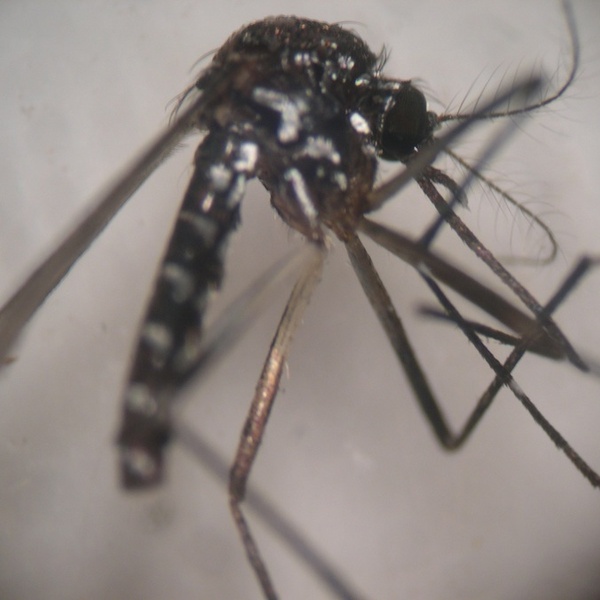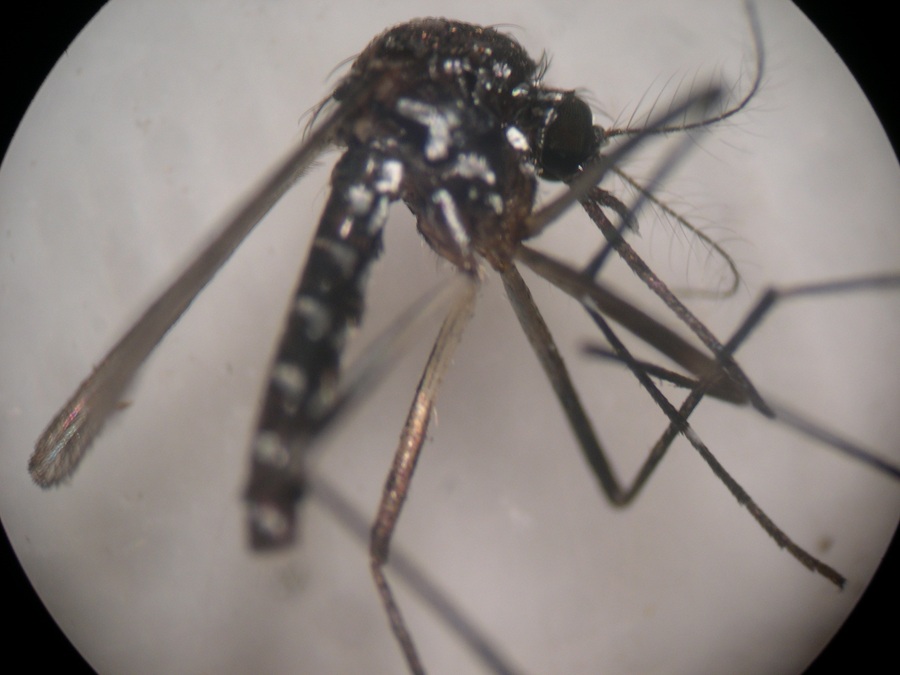Mosquitoes. Why so many?
May 21, 2025
Zanzara tigre al microscopio
Due to the heavy spring rains in natural areas (wetlands, meadows, forested areas), this year various mosquito species have developed, causing widespread infestations.
The territory of the lower Val di Susa hosts a great variety of mosquito species, over 20, which use diverse habitats as their breeding sites, all linked to the presence of stagnant, permanent, or temporary water, as mosquito larvae are aquatic.
In the Avigliana area, the breeding sites for mosquitoes are certainly wetlands, such as the Mareschi Marsh and the Trana peat bog, but also all the lands that can be subject to flooding due to rains, such as meadows, fields, and forests, in addition to the countless sites provided by people in urban areas that can be found in gardens, yards, and balconies. In inhabited areas, light rains can create breeding sites, known as outbreaks, while to turn larger areas into outbreaks, it is necessary for rainfall episodes to be at least of medium intensity, that is, more than 30 mm of rain.
This spring, as many will remember, the rainfall episodes were so intense that they triggered landslides and mudslides on hilly and mountainous slopes, leading to flooding in many parts of Piedmont. The rainfall in the territory of the Municipality of Avigliana measured 470.9 mm of rain
from March 1 to May 15 (measurement from the Avigliana station, ARPA Piedmont), but it was the peak of more than 200 mm that fell between the 16th and 18th of April that caused most of the flooding that extended from the Trana peat bog to meadow lands, forest areas, and wetlands (Mareschi Marsh) to the north of Lake Grande, including those adjacent to the shared industrial area
with the Municipality of Sant'Ambrogio. Given the amount of rainfall, and the recurrence of thunderstorm episodes in the following weeks, even large portions of the forests located at the foot of Mount Pirchiriano and Mount Cuneo have been affected by flooding.
From these inundations, various mosquito species have emerged. Currently, the species with the highest number of individuals are Ochlerotatus cantans, which arises in wetlands, and Ochlerotatus geniculatus, which occurs in forests. Both species, in years of low rainfall, remain preferably near their breeding sites, moving only a few dozen meters, while
in years of medium and heavy rainfall, following the population explosion, they can reach several hundred meters, easily arriving in villages, hamlets, and many neighborhoods of the nearby urban zone. The flooding of vast areas also occurred in the spring of last year, resulting in an increase in the eggs laid by these species that deposit eggs on moist ground, which require several inundations before hatching the following year or years.
In the past week, larval treatments have been carried out in some parts of the Avigliana territory and will be extended to all territories of the Project Municipalities (Avigliana Park and the Municipalities of Avigliana, Villar Dora, Trana, and Sant'Antonino di Susa) in the current week to reduce the presence of mosquitoes in the area. Unfortunately, larvicidal treatments in April and early May, necessary for controlling species from submerged areas, were not performed due to bureaucratic delays that prevented the start of the mosquito control project activities during the usual period.
Regarding the forest mosquito, this species cannot be subject to control through larval treatments, having outbreaks scattered over hundreds of hectares of forest. The only concrete response would be, in the opinion of Giovanna Mazzoni, project representative for biological control of mosquitoes for the Alpi Cozie Parks, to convert the old coppice forests into high-forest woods in order to significantly reduce the hollows of trees that are the preferred breeding site of Ochlerotatus geniculatus and that allow the continuous presence of this species even during less favorable seasons.
All this has led to the current situation and the great discomfort of the population, worsened by the fact that some of the emerged species are capable of remaining active even during the day in situations of overcast skies, either fully or partially, and/or high humidity in the air. The intensity of the current infestation will diminish over the weeks, similar to what occurred last year and in some of the years when the same situation arose, such as in 2013, as the females, which are the only ones to draw blood from "hosts", live between three and five weeks.
It is noted in this regard that the presence of urban mosquitoes has started, now with the native mosquito, Culex pipiens, to which the tiger mosquito, Aedes albopictus, will soon be added, so everyone should take care to eliminate possible breeding sites in gardens and plots.
It is noted that treatments are carried out on larger mosquito outbreaks (wetlands, channels, ditches, flooded meadows and fallow lands, etc.) with tractors equipped with a rubber hose that is unrolled and used to spray the product based on Bacillus thuringiensis var. israelensis by an operator. This product is harmless to people and animals, including invertebrates, except for mosquito larvae and a few other families of insect relatives of mosquitoes (diptera). For medium and small outbreaks such as street drains, debris and abandoned waste, tires, tarps, larvicidal tablets harmless to vertebrates are used.
Since the season for the presence of urban mosquitoes like Aedes albopictus or tiger mosquito and Culex pipiens, our "domestic mosquito," is about to begin and these species stay close to their birth sites, citizens are encouraged to eliminate all possible outbreaks by closing rainwater collections in gardens and plots, regularly emptying saucers, and avoiding pooling on tarps, in gutters, etc.
The presence of fish in ponds and ornamental fountains eliminates the presence of mosquitoes.
It is noted that the tiger mosquito takes advantage of the slightest trace of stagnant water, so it is necessary also to eliminate bottles and other discarded objects found everywhere in our cities.
As last year, the larvicide distributed for free to residents in the Project Municipalities is not Bacillus thuringiensis var. israelensis but a product based on PDMS silicone that forms a thin film on the water's surface preventing the breathing of mosquito larvae and pupae that use atmospheric oxygen rather than water oxygen as most aquatic animals do. It is to be used only in outbreaks where no dragonflies, fish, or amphibians are present.
The product is available at the Park Authority office located at Via Monte Pirchiriano 54 in Avigliana, which follows the following hours: 9:30 AM - 12:00 PM and 2:00 PM - 3:00 PM from Monday to Thursday and 9:30 AM - 12:00 PM on Friday; by prior telephone reservation, home delivery can be requested.
The product can also be picked up at the Technical Office of the Municipality of Avigliana, the Municipality of Villar Dora and Sant'Antonino di Susa, and at the Municipality Office of San Didero by the respective citizens who are interested.
It is recommended that managers of production activities carry out disinfestations independently, if they deem it necessary, as the use of adulticides is not included in the biological control project except during public events and, in any case, with interventions funded well in advance.
For information, call the Park Authority at numbers 011 93 13 000 or 011 43 26 589 or send an email to mazzoni@alpicozie.eu.
You might also be interested in...
- campaign Mosquito project: meetings with the population
- tactic Biological control of mosquitoes
- shopping_cart Il controllo biologico delle popolazioni di insetti. Il caso dei Culicidi dei laghi di Avigliana
- campaign Cycling in the Parks: Yes, but...
- campaign Only if necessary. Motor vehicles in the Parks
- campaign The mushrooms: a heritage of the environment and popular traditions
- campaign The foundational prohibition of parks: hunting
- campaign January with the Chantar l'Uvèrn review
- campaign Val Troncea: divieto di attività alpinistica in area di pregio naturalistico
- campaign February with the Chantar l'Uvèrn 2025 festival
 Territory
Territory
